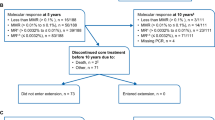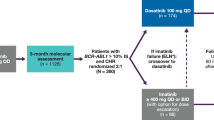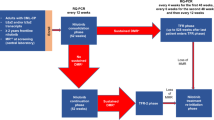Abstract
Evaluating Nilotinib Efficacy and Safety in Clinical Trials Newly Diagnosed Patients compares nilotinib and imatinib in patients with newly diagnosed chronic myeloid leukemia in chronic phase (CML-CP). With a minimum follow-up of 3 years, major molecular response, molecular response of BCR-ABL⩽0.01% expressed on the international scale (BCR-ABLIS; MR4) and BCR-ABLIS⩽0.0032% (MR4.5) rates were significantly higher with nilotinib compared with imatinib, and differences in the depth of molecular response between nilotinib and imatinib have increased over time. No new progressions occurred on treatment since the 2-year analysis. Nilotinib was associated with a significantly lower probability of progression to accelerated phase/blast crisis vs imatinib (two (0.7%) progressions on nilotinib 300 mg twice daily, three (1.1%) on nilotinib 400 mg twice daily and 12 (4.2%) on imatinib). When considering progressions occurring after study treatment discontinuation, the advantage of nilotinib over imatinib in preventing progression remained significant (nine (3.2%) progressions on nilotinib 300 mg twice daily, six (2.1%) on nilotinib 400 mg twice daily and 19 (6.7%) on imatinib). Both nilotinib and imatinib were well tolerated, with minimal changes in safety over time. Nilotinib continues to demonstrate superior efficacy in all key response and outcome parameters compared with imatinib for the treatment of patients with newly diagnosed CML-CP.
This is a preview of subscription content, access via your institution
Access options
Subscribe to this journal
Receive 12 print issues and online access
$259.00 per year
only $21.58 per issue
Buy this article
- Purchase on Springer Link
- Instant access to full article PDF
Prices may be subject to local taxes which are calculated during checkout



Similar content being viewed by others
Change history
10 October 2012
This article has been corrected since Advance Online Publication and a corrigendum is also printed in this issue
References
Weisberg E, Manley PW, Breitenstein W, Bruggen J, Cowan-Jacob SW, Ray A et al. Characterization of AMN107, a selective inhibitor of native and mutant Bcr-Abl. Cancer Cell 2005; 7: 129–141.
Tasigna (package insert). Novartis Pharmaceuticals Corporation: East Hanover, NJ, 2010.
Saglio G, Kim DW, Issaragrisil S, le Coutre P, Etienne G, Lobo C et al. Nilotinib versus imatinib for newly diagnosed chronic myeloid leukemia. N Engl J Med 2010; 362: 2251–2259.
Kantarjian HM, Hochhaus A, Saglio G, De Souza C, Flinn IW, Stenke L et al. Nilotinib versus imatinib for the treatment of patients with newly diagnosed chronic phase, Philadelphia chromosome-positive, chronic myeloid leukaemia: 24-month minimum follow-up of the phase 3 randomised ENESTnd trial. Lancet Oncol 2011; 12: 841–851.
Hochhaus A, O'Brien SG, Guilhot F, Druker BJ, Branford S, Foroni L et al. Six-year follow-up of patients receiving imatinib for the first-line treatment of chronic myeloid leukemia. Leukemia 2009; 23: 1054–1061.
Baccarani M, Cortes J, Pane F, Niederwieser D, Saglio G, Apperley J et al. Chronic myeloid leukemia: an update of concepts and management recommendations of European LeukemiaNet. J Clin Oncol 2009; 27: 6041–6051.
Larson R, Bunworasate U, Turkina A, Goldberg A, Dorlhiac-Llacer P, Lopez J et al. Nilotinib shows safety and efficacy in older patients (⩾65 years) with newly diagnosed chronic myeloid leukemia in chronic phase comparable with that in younger patients with chronic myeloid leukemia in chronic phase: results from ENESTnd. Blood 2011; 118: 1608–1609.
Cross NCP, White H, Müller MC, Saglio G, Hochhaus A . Standardized definitions of molecular response in chronic myeloid leukemia. Leukemia 2012; e-pub ahead of print 16 April 2012 doi:10.1038/leu.2012.104.
Mahon FX, Rea D, Guilhot J, Guilhot F, Huguet F, Nicolini F et al. Discontinuation of imatinib in patients with chronic myeloid leukaemia who have maintained complete molecular remission for at least 2 years: the prospective, multicentre Stop Imatinib (STIM) trial. Lancet Oncol 2010; 11: 1029–1035.
Goh HG, Kim YJ, Kim DW, Kim HJ, Kim SH, Jang SE et al. Previous best responses can be re-achieved by resumption after imatinib discontinuation in patients with chronic myeloid leukemia: implication for intermittent imatinib therapy. Leuk Lymphoma 2009; 50: 944–951.
Matsuki E, Ono Y, Sakurai M, Kunimoto H, Ishizawa J, Shimizu T et al. Discontinuation of imatinib in patients with CML and sustained complete molecular response (CMR) for over 2 years in the Japanese population—an interim analysis of KEIO STIM study. Blood 2011; 118: 1608 [abstract 3765].
Rea D, Rousselot P, Nicolini FE, Legros L, Tulliez M, Giraudier S et al. Discontinuation of dasatinib or nilotinib in chronic myeloid leukemia (CML) patients (pts) with stable undetectable Bcr-Abl transcripts: results from the French CML Group (FILMC). Blood 2011; 118: 277.
Ross DM, Branford S, Seymour JF, Schwarer AP, Arthur C, Bartley PA et al. Patients with chronic myeloid leukemia who maintain a complete molecular response after stopping imatinib treatment have evidence of persistent leukemia by DNA PCR. Leukemia 2010; 10: 1719–1724.
Acknowledgements
We thank Richard Woodman and Albert Hoenekopp (Novartis Pharmaceuticals) for providing ongoing medical and clinical support and Ariful Haque (Novartis Pharmaceuticals) for providing ongoing statistical analyses and invaluable collaboration. Financial support for medical editorial assistance was provided by Novartis Pharmaceuticals. We also thank Michael Mandola, PhD and Cornel Phillip, PhD (Articulate Science) for medical editorial assistance with this manuscript.
Author information
Authors and Affiliations
Corresponding author
Ethics declarations
Competing interests
RAL was a consultant for Novartis, BMS, Pfizer and Ariad, received research funding from Novartis, BMS and Ariad, and received honoraria from Novartis. AH received research funding and honoraria from BMS, Novartis, Pfizer, MSD and Ariad. TPH was a consultant for and received honoraria from Novartis, BMS and Ariad and research funding from Novartis, BMS and CSL. REC received research funding from Novartis and BMS, honoraria from Novartis, BMS and Pfizer, and was on the speakers' bureau for Novartis. GE has no relationships to disclose. D-WK was an advisor for and received research funding from Novartis, BMS and Pfizer, received honoraria from Novartis and BMS, was a consultant for Novartis and BMS, and was on the speaker's bureau for Novartis. IWF received research funding from Novartis. MK was on the speakers' bureau, an advisor, and received research funding from Novartis. BM was on the speakers' bureau for BMS and Novartis. RY and NJG are Novartis employees and stock holders. REB is a Novartis employee. GS is a consultant for Novartis, BMS and Pfizer and on the speakers' bureau for Novartis and BMS. HMK received research funding from Novartis, BMS and Pfizer and is a consultant for Novartis.
Additional information
Author contributions
AH and HMK designed research; RAL, AH, TPH, REC, D-WK, IWF, GS and HMK performed research; HMK contributed vital new reagents or analytical tool; AH, REC, GE, DW-K, MK, RY and HMK collected data; RAL, AH, TPH, GE, IWF, D-WK, RY, REB, NJG, GS and HMK analyzed and interpreted data; REB and HMK performed statistical analysis; and all authors drafted and approved the manuscript.
Rights and permissions
About this article
Cite this article
Larson, R., Hochhaus, A., Hughes, T. et al. Nilotinib vs imatinib in patients with newly diagnosed Philadelphia chromosome-positive chronic myeloid leukemia in chronic phase: ENESTnd 3-year follow-up. Leukemia 26, 2197–2203 (2012). https://doi.org/10.1038/leu.2012.134
Received:
Accepted:
Published:
Issue Date:
DOI: https://doi.org/10.1038/leu.2012.134
Keywords
This article is cited by
-
BCR/ABL-Positive Chronic Myeloid Leukemia in Children: Current Treatment Approach
Current Oncology Reports (2024)
-
Clinical management of second-generation tyrosine kinase inhibitor therapy in patients with newly diagnosed chronic myeloid leukemia in the chronic phase, focusing on age and dose effects
International Journal of Hematology (2023)
-
Cardiovascular Adverse Events of Tyrosine Kinase Inhibitors in Chronic Myeloid Leukemia: Clinical Relevance, Impact on Outcome, Preventive Measures and Treatment Strategies
Current Treatment Options in Oncology (2023)
-
Real-world therapeutic response and tyrosine kinase inhibitor discontinuation in chronic phase-chronic myeloid leukemia: data from the French observatory
Annals of Hematology (2022)
-
NOVEL-1st: an observational study to assess the safety and efficacy of nilotinib in newly diagnosed patients with Philadelphia chromosome-positive chronic myeloid leukemia in chronic phase in Taiwan
International Journal of Hematology (2022)



